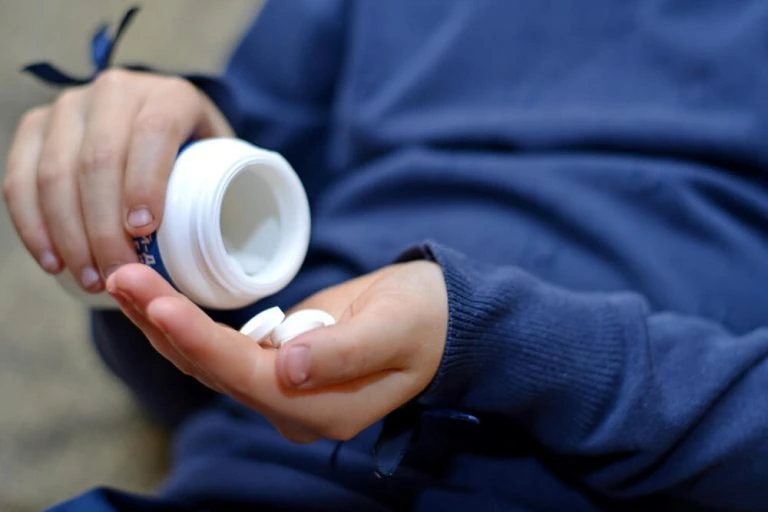Hydromorphone
Hydromorphone is an opioid analgesic that is prescribed for pain of moderate to severe intensity and for chronic pain of severe intensity.

Common Trade Names: Dilaudid, Exalgo, Palladone
Like other opioids, hydromorphone binds to opioid receptors, primarily the mu-opioid receptors, within the central nervous system (CNS). The activation of these receptors reduces the perception of pain in the body. Because it is very effective at alleviating pain, hydromorphone carries a high potential for abuse and is classified as a Schedule II drug under the federal substance scheduling system.
Hydromorphone’s Clinical Uses
Hydromorphone is primarily prescribed to treat acute or chronic pain of moderate to severe intensity. It is usually only considered for pain management of patients who require long-term, round-the-clock opioid therapy or when other treatment options have failed. Hydromorphone is also an off-label cough suppressant medication.
How People Misuse Hydromorphone
Some of the more common ways people abuse hydromorphone include the following:
- Increasing their dosages of hydromorphone without their doctor’s recommendation
- Taking hydromorphone doses more frequently than prescribed by their doctor
- Crushing and dissolving hydromorphone tablets before injecting the mixture into the body
- Crushing hydromorphone tablets and snorting the resulting powder
- Chewing extended-release hydromorphone tablets to more quickly feel the desired effects
How Hydromorphone Interacts with Other Drugs
The following medications and substances are known to interact with hydromorphone:
- Anticholinergics: When taken in combination with hydromorphone, anticholinergic medications may increase a patient’s risk of experiencing severe constipation or urinary retention. This can cause impaired bowel motor activity, a serious condition that may result in death if left untreated.
- CNS depressants: Combining hydromorphone with alcohol, centrally acting anti-emetics, general anesthetics, hypnotics, phenothiazines, sedatives, and tranquilizers may cause low blood pressure, extreme drowsiness, respiratory depression, or coma.
- Mixed agonist/antagonist opioid analgesics: Hydromorphone’s analgesic effects may be reduced when taken with agonist/antagonist analgesics or partial agonist analgesics. Combining these medications may also trigger withdrawal symptoms in a patient.
- Monoamine oxidase inhibitors (MAOIs): Patients who take MAOIs, such as isocarboxazid and linezolid, are at risk of developing serotonin syndrome should they take these medications with hydromorphone. Serotonin syndrome is a potentially life-threatening condition in which levels of serotonin in the CNS become perilously high.
Immediate Side Effects of Hydromorphone Use
Hydromorphone use can cause several adverse effects such as:
- Anxiety
- Sweating
- Flushing
- Sleeping difficulties
- Depression
- Dry mouth
- Pain in the stomach
- Itchiness
- Lightheadedness
- Drowsiness
- Headaches
- Pain in the muscles, joints, or back
Serious adverse effects of hydromorphone use include:
- Respiratory depression or respiratory arrest
- Seizures
- Syncope (loss of consciousness)
- Low blood pressure
- Adrenal insufficiency (an inability of the adrenal glands to produce certain hormones)
- Suicidal ideation
- Apnea or irregular breathing
- Increased pressure around the brain
- Coma
Should you notice any of these side effects in yourself or another person, do not hesitate to call local emergency services as soon as possible.
Long-Term Effects of Hydromorphone Use
Chronic hydromorphone use may result in effects similar to those experienced with long-term use of other opioids. One such side effect is hypogonadism, or the inability of the sex glands to produce sex hormones. This, in turn, can lead to the following conditions for both males and females:
- Anosmia (being unable to smell)
- Depression and anxiety
- Diarrhea
- Fatigue
- Galactorrhoea (a milky discharge from the nipples)
- Glucose intolerance (metabolic conditions that lead to increased blood glucose levels)
- Gynaecomastia (swelling of the breasts)
- Hypercholesteraemia (high blood cholesterol levels)
- Infertility
- Myalgia (muscle aches and pain)
- Night sweats
- Osteoporosis (weakening of the bones)
- Polyuria (excessive volumes of urination)
- Reduced libido
Additionally, newborn children of women who use or misuse hydromorphone for a long time can develop neonatal withdrawal syndrome. Symptoms of this condition include:
- Excessive crying
- Fever
- Hyperactive reflexes
- Increased respiratory rate
- Increased stools
- Irritability
- Sneezing
- Tremors
- Yawning
- Vomiting
Symptoms of Hydromorphone Overdose
An opioid overdose can occur if you misuse hydromorphone. Signs and symptoms of hydromorphone overdose include:
- Confusion
- Constriction of the pupils
- Cold or clammy skin
- Cyanosis (bluish skin)
- Dizziness
- Weak blood pressure
Should you or another individual exhibit any of the symptoms mentioned above, call 911 immediately. Also ask your doctor about getting a rescue drug called naloxone, as it can reverse the harmful side effects of a hydromorphone overdose.
Signs of Hydromorphone Addiction
As a Schedule II controlled substance, hydromorphone is associated with a high risk of dependence or abuse. Patients with a history of substance use disorder are also at an increased risk of developing an addiction to hydromorphone.
The Diagnostic and Statistical Manual for Mental Disorders, Fifth Edition (DSM-5) lists 11 distinct criteria for identifying whether a person may have a substance use disorder. These same criteria can be referred to when determining if an individual has hydromorphone addiction:
- Taking hydromorphone in excessive doses or for an extended period
- Not managing to reduce or stop hydromorphone use, despite desiring to
- Spending a lot of time trying to get, use, or recover from using hydromorphone
- Craving for or having strong urges to use hydromorphone
- Experiencing an inability to manage personal, social, and family obligations because of using hydromorphone
- Experiencing relationship problems stemming from chronic hydromorphone use
- Failing to attend important activities due to hydromorphone use
- Repeatedly and continually using hydromorphone even if it will put you in danger
- Continuing to use hydromorphone despite worsening or exacerbation of existing medical conditions
- Requiring a higher dose of hydromorphone to achieve or maintain its desired effects (tolerance)
- Developing hydromorphone withdrawal symptoms after abruptly stopping its use
Symptoms of Hydromorphone Withdrawal
In cases of hydromorphone withdrawal, the patient may show the following symptoms:
- Lacrimation (excessively teary eyes)
- Rhinorrhea (runny nose)
- Nausea or vomiting
- Anorexia (lack or loss of appetite)
- Diarrhea or abdominal cramps
- Myalgia (muscle aches and pain)
- Mydriasis (dilation of the pupil)
- Insomnia
- Anxiety, irritability, or restlessness
- Chills or sweating
- Pain in the back or joints
- A significant increase in heart rate, blood pressure, or respiratory rate
- Yawning or feeling weak
Experiencing any or all the above withdrawal symptoms may be a sign that you have developed hydromorphone dependence. This can happen if you’ve been using the drug non-stop for a long time, whether you did so as prescribed or you misused it.
That said, dependence is not the same as addiction. Dependence simply means that your body has adjusted to always having the drug in your system, which is why suddenly ceasing intake of the substance can cause withdrawal symptoms.
You can also develop dependence if you have a substance use disorder. The difference is that being addicted means you have trouble stopping yourself from taking the drug, even if you are aware that continuing to do so can put you in harm’s way.
If you’d like to quit using hydromorphone, don’t abruptly stop taking it. Reach out to your doctor or a medical detox facility and ask them about undergoing a detoxification program. This will allow you to slowly and comfortably get the drug out of your system and help you manage the withdrawal symptoms in a safe environment.
Hydromorphone Detox
For individuals who have developed a dependence on hydromorphone, abrupt discontinuation is not recommended under any circumstance. This is because doing so can lead to severe withdrawal symptoms such as those mentioned above. Instead, it is recommended that you consult a medical professional regarding hydromorphone detoxification.
Detoxification, or detox, refers to the process of eliminating the accumulation of a certain substance to stop it from further harming the body. When applied to hydromorphone dependence, the patient is slowly weaned off hydromorphone by tapering the doses over several weeks. After this is done, the patient may be put on another medication that has the same analgesic effects as hydromorphone but with a lower potential for abuse.
Completing the detoxification process is just the first step in your recovery journey. Indeed, detoxification is only one part of the many interventions for addressing hydromorphone abuse.
Treatment Methods for Hydromorphone Addiction
Recovering from hydromorphone use disorder can be difficult. That said, you don’t necessarily have to go through the journey alone, as there are hydromorphone addiction treatment programs that can help you get started on achieving sobriety.
Generally speaking, treatment programs for hydromorphone use disorder are carried out in two kinds of settings:
- Outpatient hydromorphone addiction treatment: Typically recommended for individuals who are considered to have a low-risk profile, outpatient addiction treatment allows you to live at home rather than at a rehabilitation facility. This setup will let you enjoy your usual daily activities and won’t disrupt your school, work, or personal obligations However, you will be required to attend regular therapy and counseling sessions at your designated treatment center. If you have a strong support system from your family and are diagnosed with a much milder form of addiction, outpatient treatment may be best for you.
- Inpatient hydromorphone addiction treatment: This type of addiction treatment is usually recommended for people who are considered to be high-risk patients. An inpatient setting will require you to stay at a rehabilitation facility so that your recovery can be supervised by a team of medical professionals around the clock. You will undergo a combination of treatment modalities, which may include individual or family therapy, drug education sessions, group counseling, and medication-assisted treatment.
Hydromorphone addiction treatment programs, whether done in an inpatient or outpatient setting, often employ a multimodal approach that incorporates behavioral and psychosocial interventions. These aim to reduce relapse episodes and promote abstinence by targeting specific problem areas that predispose patients to addiction. More specifically, these interventions can help them identify their relapse triggers and teach them ways on how to overcome them.
Call a Recovery Support Advisor to Get the Help You Need
For people suffering from hydromorphone addiction, it’s never too late to overcome it. The important thing is to start seeking help as soon as possible. If you have insurance, you likely won’t have to pay for your addiction treatment out of pocket, as most insurance policies have some form of coverage for addiction treatment services.
Take the first step in your recovery by giving us a call at (800) 429-7690. A recovery support advisor will take your call and help you figure out the best form of treatment for you. They can also check how much of the treatment program will be covered by your insurance plan, and they can assist you in looking for other ways to finance it, if necessary. They will also help you in finding a suitable treatment center.
A Brief History of Hydromorphone
Hydromorphone has been commercially available in the U.S. since the 1920s. In 1992, the 8-milligram Dilaudid formulation was approved. The 2-milligram and 4-milligram formulations were later approved in 2007.
In 2004, an extended-release formulation under the brand name Palladone was approved. However, when it was found that the drug showed extensive dose-dumping when taken with alcohol, it was taken off of the market a year later.








